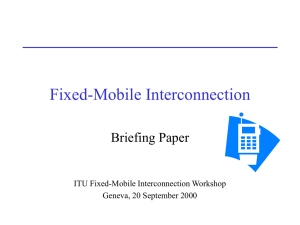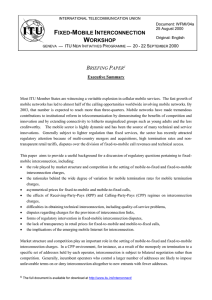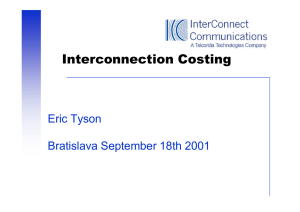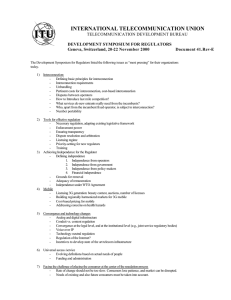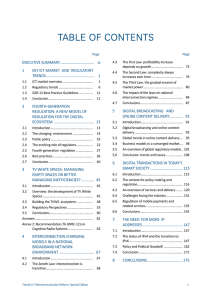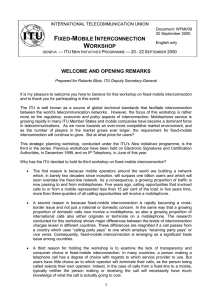2EMHFWLYHV Fixed-Mobile Interconnection
advertisement
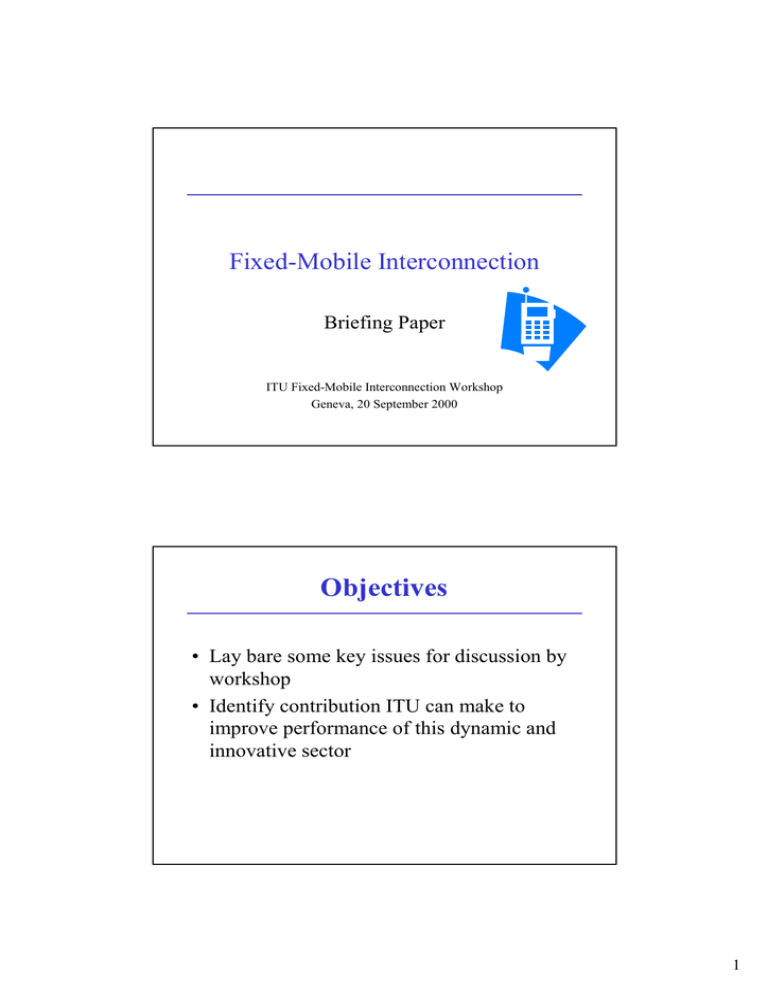
Fixed-Mobile Interconnection Briefing Paper ITU Fixed-Mobile Interconnection Workshop Geneva, 20 September 2000 2EMHFWLYHV • Lay bare some key issues for discussion by workshop • Identify contribution ITU can make to improve performance of this dynamic and innovative sector 1 ,PSRUWDQFHRI)L[HG0RELOH ,QWHUFRQQHFWLRQLVLQFUHDVLQJ Worldwide calling opportunities: Among mobile and fixed-line users (1993, 1998 and forecast 2003) )0 0REWR 0) 0RE 0RELOHWR )L[HG )L[HGWR)L[HG )L[HGWR)L[HG 1993 )WR0RELOH 0RELOH 1998 0RELOHWR PRELOH 2003 )L[HGWR )L[HGWR)L[HG )L[HGWR)L[HG )L[HGWR IL[HG 0RELOHWR )L[HGWR IL[HG PRELOH 6RXUFH,78 &DOO7HUPLQDWLRQ • Calling parties seek to terminate calls at specific addresses (numbers) that are controlled by specific operators – No practical alternative but specific operator • Operator controlling more valuable (or larger set of) addresses has incentive to refuse interconnection or price high • “Primary interconnectivity rule”: SMP operator shall interconnect at cost 2 &DOO7HUPLQDWLRQ • Unintended consequence: Smaller operator may overprice • Exacerbated by CPP environment – where fixed customer pays – where fixed operator may have incentive to cross-subsidize mobile • Some customer interests not represented in bilateral negotiations by operators &DOO7HUPLQDWLRQ • Lack of transparency of charges does not allow customers to exercise informed choice • Increased competition in the form of additional licensees does not affect termination charges, though improving performance in other aspects 3 ,QWHUFRQQHFWLRQ5DWHVLQ 6HOHFWHG&33DQG533&RXQWULHV 3HUPLQXWHLQ86 Costa Rica Malaysia Guatemala Mexico Cambodia Dom. Rep. Philippines Botswana &33FRXQWULHV 0.017 0.017 0.034 0.034 0.047 0.047 China Mobile-to-fixed interconnect rate Canada Fixed-to-mobile interconnect rate HK SAR 0.026 Singapore 0.064 533FRXQWULHV 0.002 0.001 0.007 0.000 0.008 Mobile-to-fixed interconnect rate Fixed-to-mobile interconnect rate 0.008 0.008 0.000 0.050 0.070 Sri Lanka 0.042 0.009 0.000 0.020 0.020 USA 0.078 0.051 0.205 0.052 RPP 0.208 0.293 0.293 Antigua $YHUDJH 0.009 0.005 0.056 CPP 0.092 6RXUFH,785HJXODWRU\6XUYH\)0,&DVH6WXGLHV ,QWHUFRQQHFWLRQ5DWHVLQ (XURSHDQ&RXQWULHV (XURSHDQIL[HGWRPRELOHLQWHUFRQQHFWFKDUJHV Norway UK Denmark 0.18 0.18 Spain 0.20 France 0.20 Austria Italy Germany (US cents per min.) Fixed-tomobile 0.17 Belgium Sweden (8UDQJHRILQWHUFRQQHFWUDWHV 0.16 Netherlands Finland (US$/min) 0.156 Mobile-to-fixed DOUBLE TRANSIT Lowest Best-practice (20%) guideline Mobile-to-fixed SINGLE TRANSIT 0.21 0.22 Highest 0.23 Mobile-to-fixed LOCAL 0.23 0.24 0.30 Switzerland , 6RXUFH&RPSLOHGIURP,785HJXODWRU\6XUYH\ 0 5 10 15 20 25 30 (XURSHDQ8QLRQ(&7$ 4 )0007HUPLQDWLRQ&KDUJHV • Absence of cost orientation indicated by – Wide range of fixed-to-mobile charges in Europe – Mobile-to-mobile charges being generally lower than fixed-mobile charges 3K\VLFDO/LQNV • Where regulator is not involved, charges for physical links may be set to burden mobile operator • Incumbent may have incentive to limit points of interconnection – In some cases, with effect of increasing charges – Increasing vulnerability of mobile network to congestion 5 5HJXODWLQJ)0,QWHUFRQQHFWLRQ • Some NRAs subject to overarching principles – Signatories to GATS Protocol 4, Regulatory Reference Paper – European Union directives • Includes principle of cost-oriented, nondiscriminatory interconnection by major suppliers/ operators with SMP 5HJXODWRU\3URFHVV • Current practice is to require commercial negotiation, with regulatory intervention as backstop • Regulators face serious resource limitations – Bilateral relations increase with higher number of operators – Cost studies, especially of mobile termination, may be problematic and time-consuming 6 5HJXODWRU\3URFHVV • Prioritizing intervention – Conventional market share – Based on calling opportunities • Prevent lock-in of outcome at moment of entry by mobile operator • Reducing complexity (and workloads) – “Most Favored Nation” – Require/encourage/allow clustering 5HJXODWRU\3URFHVV • Alternative Dispute Resolution may be of value – Mediation, backstopped by formal proceedings – Arbitration • Conventional • “Final offer” • Other 7 &RVW6WXGLHV • Generally accepted that mobile termination costs may be higher than fixed, because of additional mobile network elements • Higher proportion of joint and common costs in mobile than in fixed • Rapid rates of technological change and cost reductions cause difficulties • 3G licensing exacerbates costing problems %HQFKPDUNLQJ • Difficulties and delays associated with formal costs studies may be sidestepped by benchmarking, i.e., – EU best practice guidelines: upper limit of lowest three rates – ITU-T draft recommendation on settlements: average of lowest 20 percent of rates 8 0RELOH,QWHUQHW • Current minute-based interconnection arrangements may have to be revised because of – Messaging in the context of “always on” mobile networks • SMS as precursor? • Message or volume-based or flat-rate? – Information retrieval, with asymmetric flows 0RELOH,QWHUQHW • Possible lessons from – Internet interconnection, peer vs client? – Canadian two-tier mobile interconnection system? • Studies needed 9 5ROHIRUWKH,78" • NRAs require knowledge of – Best practices on all aspects of fixed-mobile interconnection – Simple and easy to implement cost methodologies – Benchmarks, possibly ranges of acceptance – Challenges of the mobile Internet 5ROHIRUWKH,78" • ITU is well positioned because of its broad membership • Publication of rates and related information can have beneficial effects on behavior of both regulators and operators • Provide virtual (www.itu.int/interconnect) and face-to-face spaces for sharing knowledge/ resolving problems 10
